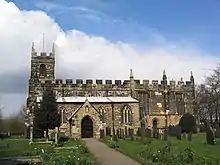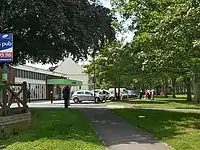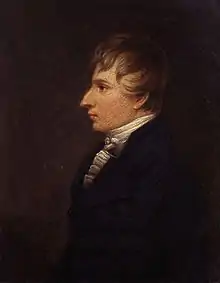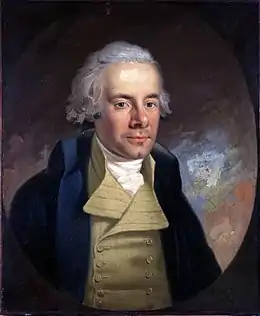Wilford
Wilford is a village close to the centre of the city of Nottingham, UK. The village is bounded to the north and west by the River Trent and to the east by the embankment of the now closed Great Central Railway.
| Wilford | |
|---|---|
 Wilford Village Green | |
 Wilford Location within Nottinghamshire | |
| Population | 4,428 |
| OS grid reference | SK 56463 36875 |
| Unitary authority | |
| Ceremonial county | |
| Region | |
| Country | England |
| Sovereign state | United Kingdom |
| Post town | Nottingham |
| Postcode district | NG11 |
| Dialling code | 0115 |
| Police | Nottinghamshire |
| Fire | Nottinghamshire |
| Ambulance | East Midlands |
| UK Parliament | |
History
Early settlements
Remains of a paved Roman ford, bordered by oak posts, were found in the Trent at Wilford in 1900. The settlement is named as Willesforde in Domesday Book, owned by William Pevrel of Nottingham Castle, who also owned the lands of nearby Clifton. It had a fishery, a priest and 23 sokemen. The land passed to the Clifton family in the 13th Century.
Development
Wilford retained its identity as a village until the later 19th century. Surrounded by woodlands and with riverside amenities such as the Wilford Ferry Inn, the village attracted many visitors from Nottingham. Spencer Hall, the Nottinghamshire poet, wrote in 1846 "Who ever saw Wilford without wishing to become an inmate of one of its peaceful woodbined homes."
In 1870 the Clifton Colliery opened on the north side of the Trent, and the area opposite Wilford became industrialised. By the end of the century the village had changed character, with modern brick-built houses replacing old thatched cottages.
Expansion
The parish was divided into North Wilford and South Wilford in 1887. The population increased to four and a half thousand by 1901, almost a ten-fold increase since 1801. The now demolished coal-fired Wilford Power Station was built in the early 1920s on the north bank of the River Trent. The civil parish of South Wilford became part of West Bridgford urban district in 1935.
The Silverdale housing estate was built on the southern edge of Wilford on farmland. An adjacent estate, Compton Acres, was built in 1986.
Education

Within the area of Wilford, there are two Primary Schools
- St. Patrick's Catholic Primary School
- South Wilford CofE Primary School
The Old School House at South Wilford houses St Wilfrid's Church Playgroup and Nursery.
There are also two Secondary Schools in Wilford
Wilford is also in the catchment area of
Located nearby is the Clifton Campus of Nottingham Trent University.
Wilford Church

The church of St Wilfrid serves a parish covering Wilford, Silverdale and a large part of the Compton Acres estate. The church dates from the late 14th century. It is considered to have been founded by Gervase de Wilford around 1361.
The church contains two memorials to the Nottingham poet Henry Kirke White who drew much of his inspiration from Wilford and Clifton. He is said to have spent much of his time writing poems sat in the churchyard under his favourite tree. The churchyard also contains the grave of Captain John Deane, an adventurer and mercenary who lived in the village.
The churchyard contains war graves of eight soldiers of World War I and an airman of World War II[1] - that of Albert Harvey Iremonger, son of Albert Iremonger - both local residents.
In the churchyard is a gazebo, built in 1757. In 1980 it was restored after a fire four years earlier. Located next to the River Trent the basement was at one time used as a mortuary.
Wilford sports clubs
Wilford has a number of sports clubs for football, rugby, basketball, bowls and archery.
- Nottingham Moderns Rugby Club is an amateur rugby club playing in the RFU league system. They have pitches and a clubhouse located between the Ferry Inn pub and the toll bridge.
- Wilford Wasps Basketball Club
- Wilford Mavericks FC
- Wilford Bowls Club (currently closed)
- Wilford Bowmen (shooting takes place in the walled garden, Wollaton Hall)
Transport

Wilford is served by two stops of the Nottingham Express Transit system. Both Wilford Village and Wilford Lane stops are on line 2, linking the city centre to Clifton, and opened in August 2015.[2][3]
Local amenities

Wilford Toll Bridge was converted to a foot bridge in the early 1970s and in the late 2010s was expanded to accommodate Nottingham Express Transit second phase extension south of the city to Clifton
St Wilfrid's Church, Wilford features two community spaces: the Church Hall and the Benjamin Carter Hall, both adjoined, at the entrance to the Church Paddock. The Carter Hall was built using proceeds left by Benjamin Carter.
Across Wilford Toll Bridge is Victoria Embankment, which hosts the annual Riverside Festival, the War Memorial and park, and a children's play-area and large paddling pool.
Close by is the Gresham Sports Pavilion which includes an all-weather football pitch, and indoor changing facilities.
Business

Wilford has a Co-operative Local Store, the Tailor's Arms (formerly the Wilford Green), the Ferry Inn (a restaurant of the Chef and Brewer chain) and the Wilford Farm Harvester (a restaurant of the Harvester chain). At the southernmost point of Wilford is the Apple Tree Pub (a restaurant of the Ember Inns chain).
Gleeds, an architects and surveyors company, until recently, has its headquarters in Wilford House. A number of companies are based at Wilford Industrial Estate, including Seriff, a large supplies distribution company, and A. W. Consulting, a small marketing consultancy, owing to the area's proximity to the A52 and access to the M1.
The former Wilford Power Station, closed in 1981 and demolished shortly afterwards, is now the location of the Riverside Retail Park with stores including Boots UK, B&Q and Argos.
Wilfordians
Residents of Wilford are known as Wilfordians. The earliest written record of this can be found in Robert Mellors', 'Old Nottingham suburbs: then and now.[4]
Notable families
Iremonger:

%252C_of_Broxtowe%252C_Nottinghamshire).svg.png.webp)

- James Iremonger was an English cricketer and noted as one of the players most unlucky never to play Test cricket. James also played football for Nottingham Forest making his debut as a fullback in 1896 against Stoke City and earned 3 caps for England.
- Albert Iremonger was a football goalkeeper and county-class cricketer. He was widely regarded as one of the best goalkeepers of his time and is a local legend in his home county of Nottinghamshire. It is also believed Iremonger was the tallest player in the league at the time, measuring 6 ft 5in.[5][6] He was landlord of The Ferry Inn until his death in 1958.
- Harry Iremonger was an English professional football goalkeeper who played in the Football League for Nottingham Forest. Iremonger fought with the 17th (Service) Battalion of the Duke of Cambridge's Own (Middlesex Regiment) during the First World War.[7]
- Albert Harvey Iremonger, born in 1920 to Albert, fought as a Sergeant-Pilot in the RAF. He was killed in action on 14 July 1943, aged 27, and is interred in the graveyard of St Wilfrid's Church, Wilford[8]
- Abel Smith II (14 March 1717 – 12 July 1788) was a British Member of Parliament and one of the leading bankers of his time. He is the grandson of Thomas Smith the founder of Smith's Bank, believed to be the first bank to be formed outside London.[11] He substantially increased the scale of the enterprise, opening banks in Lincoln and Hull and, most importantly, the London firm of Smith & Payne. His son, Samuel Smith, is believed to have constructed Wilford House on Clifton Lane where Abel later died in 1788, aged 71. By way of marriage, he was the uncle of William Wilberforce, the noted campaigner for the abolition of slavery.[12]
- Abel Smith III was the second son of Abel Smith II, a Nottingham banker and Member of Parliament. Abel was elected Member of Parliament for Nottingham; however, he died only three months later.
- Robert Smith, 1st Baron Carrington was the third son of Abel Smith (1717–1788), a wealthy Nottingham banker and Member of Parliament. He succeeded his elder brother Abel as MP for Nottingham. He was reelected for Nottingham in 1780, 1784, 1790 and 1796.[13] In 1796, he was raised to the Peerage of Ireland as Baron Carrington, of Bulcote Lodge.[14] The following year he was made Baron Carrington, of Upton in the County of Nottingham, in the Peerage of Great Britain, and had to vacate his seat in the House of Commons.[15]
- Samuel Smith was the fourth son of Abel Smith II, a wealthy Nottingham banker and Member of Parliament. Smith entered Parliament in 1788 as member for St Germans,[16] and was an MP for the next 44 years, also representing Leicester (1790–1818), Midhurst (1818–1820) and Wendover (1820–1832). In 1826, being the longest continually-serving MP, he became Father of the House.
- George Smith was the fifth son of Abel Smith II, a wealthy Nottingham banker and Member of Parliament. Smith entered Parliament in 1791 as member for Lostwithiel, and also represented Midhurst and Wendover in a parliamentary career spread over forty years.
- John Smith was the sixth son of Abel Smith II, a wealthy Nottingham banker and Member of Parliament. Smith served as a Tory Member of Parliament for Wendover from 1802 to 1806 and later represented Nottingham from 1806 to 1818, Midhurst from 1818 to 1830, Chichester from 1830 to 1831, and Buckinghamshire from 1831 to 1835.
- Henry Smith (1794-1874) was the third son of Samuel Smith. He is known for building the Infant School, located on Main Road in Wilford, and was High Sheriff of Nottinghamshire in 1841.
Individuals


- Marjorie Bates lived in The Grange (now Grange Close). She was an artist specialising in watercolour and pastels, who painted a number of views of the village.
- Laura Knight, distantly related to Majorie Bates, visited the village many times, also basing much of her work on the surrounding environment.
- Captain John Deane, an adventurer and mercenary, lived in the village. His ship The Nottingham Galley sank off the coast of Boon Island, New England in 1710. Deane and his crew, trapped on the island, were forced to cannibalise a corpse shortly before being rescued. Deane subsequently served in the Russian navy under Peter the Great, and retired to Wilford in 1736. He is buried in the grounds of St Wilfrid's Church, Wilford.
- Henry Kirke White (1785–1806) lived at Wilford Crossroads, opposite Wilford House, between 1804 and 1805. He drew inspiration for much of his poetry from Wilford and the surrounding area. He died one year later having left to study at St John's College, Cambridge.
- William Wilberforce regularly stayed at Wilford House, the seat of his Uncle, Abel Smith often for months at a time. Wilberforce stayed for several months between the years of 1786 and 1789 during the height of his campaign for the abolition of slavery.[17] Abel Smith, son of Samuel Smith, was a close friend, colleague, and chosen by Wilberforce to be the executor of his will.[18]
- Jeremiah Brandreth was born here in 1790.[19][20] In 1817 he participated in a conspiracy to overthrow the government, was arrested, tried for treason and hung with two accomplices. Their corpses were decapitated with an axe.[21]
- Rev. Benjamin Carter founded the local primary school, whilst also establishing much housing and charitable help throughout Wilford.
- In 1908, Jesse Boot built the Dorothy Boot Homes (11 homes, a clubroom and library) in Wilford, for veterans of the Crimean War and Indian Mutiny.
- Thomas Forman, founder of the Nottingham Post, bought Wilford House from the Smith family following the newspaper's successful launch.[22][23]
- Dominic Heale from East Midlands Today lives in the village.
Nature
Wilford has two Green Flag Award recognised open spaces, Ruddington Lane Park and Iremongers Pond.
Wilford is home to a number of nature reserves – two being Sites of Special Scientific Interest (SSSI) managed by the Nottinghamshire Wildlife Trust
- Wilford Claypit Nature Reserve
- Wilwell Cutting
Wilford also has a number of Sites of Importance for Nature Conservation
- Iremongers Pond SINC; which is now cared for by the Iremongers Pond Association
- Gresham Marshes SINC; which is managed by the Nottinghamshire Wildlife Trust
- Trentside SINC
- Wilford Disused Railway is also designated as a SINC
Local Landmarks and Historic Features
See also
References
- CWGC Cemetery Report. Breakdown obtained from casualty record.
- "Extending your Tram Service" (PDF). Nottingham Express Transit. Archived from the original (PDF) on 7 August 2015. Retrieved 5 August 2015.
- "Nottingham Express Transit Phase 2 opens". Railway Gazette. DVV Media UK Ltd. 25 August 2015. Archived from the original on 28 August 2015. Retrieved 25 August 2015.
- Mellors, R. (1914) Old Nottingham suburbs: then and now. Nottingham: J. & H. Bell Ltd
- Nottingham Evening Post Bygones page 33 Friday 2 May 2008 edition
- The Legends of Notts County, Dave Bracegirdle 2005 page 91 ISBN 1859834639
- "Nottingham Forest at 150: Footballers called to arms for the war". Nottingham Post. Archived from the original on 21 September 2015. Retrieved 14 December 2015.
- Roll of Honour - Lincolnshire - Gedney Hill and District Memorial Hall
- Mellors, R. (1914) Old Nottingham suburbs: then and now. Nottingham: J. & H. Bell Ltd
- Leighton-Boyce, J. (1958) Smiths the Bankers 1658-1958 London: privately published by National Provincial Bank
- J. Leighton Boyce, Smith's the Bankers 1658–1958 (1958).
- "Smith, Samuel, Brothers & Co | RBS Heritage Hub". www.rbs.com. Retrieved 16 July 2020.
- "SMITH, Robert (1752-1838), of Bulcot, Notts". History of Parliament Online. Retrieved 1 November 2017.
- "No. 13914". The London Gazette. 23 July 1796. p. 705.
- "No. 14052". The London Gazette. 7 October 1797. p. 968.
- Leigh Rayment's Historical List of MPs
- Wilberforce, R. I. & S. (1839). The Life of William Wilberforce (PDF). London: John Murray. Retrieved 16 July 2020.
- Barber, Jill. "Letters from anti-slavery campaigner William Wilberforce to Abel Smith". Herts Memories. Retrieved 16 July 2020.
- Leibensperger, Summer D. (20 April 2009). Brandreth, Jeremiah (1790–1817) and the Pentrich Rising. In The International Encyclopedia of Revolution and Protest, I. Ness (Ed. Hoboken, New Jersey. USA.: John Wiley & Sons, Ltd. Retrieved 10 July 2020.
- Jeremiah Brandreth at schoolnet Archived 30 June 2007 at the Wayback Machine accessed July 2007
- Hanging, Drawing and Quartering accessed July 2007
- accessed June 2015
- "Towns and Villages Around Nottingham | Wilford". www.visitoruk.com.








